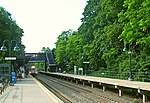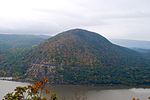Storm King Highway

The Storm King Highway is a three-mile (4.8 km) segment of New York State Route 218 (NY 218) between Lee Road in the Town of Highlands at the south end and the Cornwall-on-Hudson village line in Orange County, New York, in the United States. It was built in 1916 and added to the National Register of Historic Places in 1982 in recognition of its accomplishment in civil engineering. It is so named because it winds around the steep slopes of Storm King Mountain near its north end of the Hudson Highlands on the west bank of the Hudson River. Here it reaches heights of up to 420 feet (130 m) above the water, with panoramic views of the river and surrounding mountains such as Breakneck Ridge and Bull Hill. Several small pullouts allow drivers to stop and enjoy the view. When built it took 22 miles (35 km) off the trip between Cornwall and Newburgh to its north with Highland Falls and West Point to its south. It remains in use by commuters, though a bypass, now part of US 9W, was built, further shortening travel times while still offering panoramic views.
Excerpt from the Wikipedia article Storm King Highway (License: CC BY-SA 3.0, Authors, Images).Storm King Highway
Storm King Highway,
Geographical coordinates (GPS) Address External links Nearby Places Show on map
Geographical coordinates (GPS)
| Latitude | Longitude |
|---|---|
| N 41.4175 ° | E -73.973333333333 ° |
Address
Storm King Highway
Storm King Highway
10996
New York, United States
Open on Google Maps











